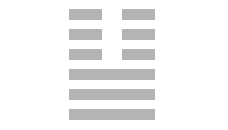Once we have formulated our question to the I Ching and determined the oracle‘s response, we now have the answer of the I Ching in the form of a hexagram.

A hexagram (where hexa is the Greek prefix for six, referring to six lines) is built from bottom to top, and that is also the way it is read. The lower trigram (with a purple frame) is followed by the first core character (turquoise frame), then the second core character (green frame) and the hexagram ends with the upper trigram (with a light green frame).
A Hexagram Consists of Trigrams and Core Characters
Trigram (where tri means three) refers to a character composed of three lines, whether broken or solid. The lower trigram (with a purple frame) and the upper trigram (with a light green frame) are always called trigrams. The two core characters (with turquoise and green frame) are also trigrams, but due to their position within the hexagram, they are referred to as the first and second core characters.
For example the hexagram depicted above consists of the following trigrams:
| upper trigram | Kun, the earth |
| second core character | Zhen, the thunder |
| first core character | Dui, the lake |
| lower trigram | Qian, the heaven |
The no2DO Interpretation Model
If we read the trigrams and core characters of a hexagram (as seen in the table of our example hexagram) from bottom to top, we obtain the following basic interpretation: Qian, the heaven, transforms into Dui, the lake. From there Zhen, the thunder, emerges which further develops into Kun, the earth. This reading corresponds to the interpretation model of no2DO, where a hexagram is deconstructed into its trigrams and core characters, and consistently read from bottom to top.
So far I have not encountered this method of reading in the I Ching literature. However, since a hexagram is constructed in this precise manner during the process of oracle consultation – from bottom to top – this approach appears to be logically sound to me. In any case, the interpretation model has proven o be helpful in practical application.
Excursus: Complete interpretation of hexagram 12 – peace
Excursus: The no2DO interpretation model


